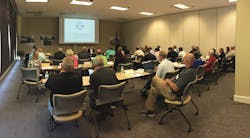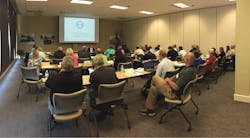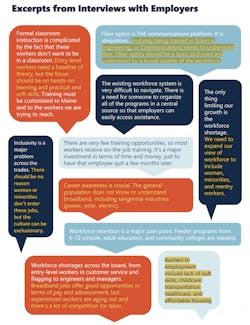Can Our Industry Develop Fiber Talent?
It Takes More Than You Think
Recently, the shortage in the fiber optic workforce has gained national attention because the billions of dollars of federal spending for infrastructure and broadband will create an even worse shortage of competent fiber optic techs.
“Kentucky state officials hired contractors who then needed local workers. The FOA was asked if we could help because we already had a trainer offering classes in Kentucky. They asked how many FOA certified fiber optic techs lived in Kentucky. We searched our database and told them two. That’s right two. That wasn’t going to help very much.”
As the state broadband agencies try to understand how to take part in these federal funding programs, they are learning how big a problem the shortage of fiber optic techs really is. Late last year, the FOA was contacted by a state agency which was starting a fiber optic middle mile project asking if the FOA could help get more contractors to bid on this large project. We contacted some contractors and were told that they were completely booked up and did not have workers to bid on any new jobs.
Training – The Right Way
The FOA is now working with state workforce development agencies to help them create programs that can train enough techs to meet their demand. We begin by telling them this story about Kentucky Wired to show how it can work.
Kentucky decided to build their own statewide fiber optic network, Kentucky Wired, to connect all 95 counties, many of which had no modern telecom infrastructure because no telecom company was interested. You know all the arguments about building infrastructure in rural and low-income areas, right?
Kentucky state officials hired contractors who then needed local workers. The FOA was asked if we could help because we already had a trainer offering classes in Kentucky. They asked how many FOA certified fiber optic techs lived in Kentucky. We searched our database and told them two. That’s right two. That wasn’t going to help very much.
But the FOA had a useful contact. One of the schools that was part of the Kentucky Community and Technical Colleges System (KCTCS) was FOA approved for years and the instructor, Tom Collins, was a FOA Director. We brought him into the conversation.
Everyone agreed that it was necessary for Kentucky to set up a program to develop their own workforce, but it was necessary to ensure all parties were on the same wavelength. With everyone’s cooperation, FOA flew to Kentucky to run a meeting of all the parties involved, including the state agency overseeing the project, the contractors tasked with building the network, and representatives from all the KCTCS locations. (See Figure 1.)
The agenda for the meeting was simple—tell everyone about your needs. The state agency reviewed the plans for Kentucky Wired and the contractors made presentations about their needs for the workforce. The contractors all talked about what kinds of workers they wanted: workers who showed up every day, were not afraid of work, would take direction, wanted to learn a skilled trade, etc. Interestingly, competency as fiber techs was not on top of their list because they understood that these workers would learn by OJT (on-the-job-training), and workers who had completed a basic fiber course for FOA certification would be well prepared.
KCTCS officials talked about their state-wide network of schools and how the FOA program had been very successful at one location already. The FOA followed to explain our role in helping schools get started, providing curriculum, assistance in setting up facilities including hands-on labs, tutoring instructors, and providing certifications to their students. And we answered a lot of questions.
Everyone agreed on creating a network of schools and making funding available to start the programs as soon as possible.
Kentucky Wired finished connecting all 95 counties with fiber in late 2022. During that time, nine schools in the KCTCS system (located around the state) trained and certified 1,200 CFOT®s (FOA Certified Fiber Optic technicians). These techs worked for the contractors, continued learning by OJT, and helped make Kentucky Wired a reality. Many of these CFOTs were retrained from other low-income jobs, including laid-off coal miners—the ideal outcome of a workforce development program.
Now that all 95 Kentucky counties are connected to the backbone, it’s the responsibility of the local counties to build-out connectivity to their citizens and businesses. Thanks to the cooperation between the state agencies, KCTCS, and the contractors, there is now an experienced local workforce around the state trained and certified in fiber optics ready and able to build out the local networks.
That’s what workforce development is all about, isn’t it—training and/or retraining workers for available well-paying jobs?
The lesson here is that success depends on cooperation. No state broadband or workforce agency, no school or training organization, no contractor, nor any other organization can make it happen alone. They must work together and build on each of their strengths to make their programs a success.
We recently told this story to the workforce group the FOA is helping in the state of Maine. They had hired outside consultants, Camoin Associates, to create the Maine Broadband Workforce Strategy report (www.maineconnectivity.org/workforce). It’s important to note the scale of need along with the job titles that are missing from Maine’s workforce. The page of quotes from employers they interviewed is noteworthy as well. Read the sidebar, “The Maine Thing”, for insights other states and broadband providers should focus on during this historic time—fiber investment is right around the corner.
The Maine Thing
In Q1 2023, The Maine Connectivity Authority (MCA) hired Camoin Associates and its partner, Thomas P. Miller and Associates, to assess Maine’s broadband workforce in order to:
- Determine which occupations will be most critical for deploying broadband across the state.
- Gauge the scale of any workforce shortages.
- Craft strategies for how MCA should address employer needs and address barriers experienced by potential workers.
What they found was quite interesting. According to the report, Maine is projected to have an average shortfall of 3,240 – 4,531 workers in the top broadband occupations across the economy if the state receives incremental broadband investments in the range of $100 million – $350 million respectively.
While there are several training programs across the state for the more general Top Broadband Occupations, there are only a handful of training programs in existence for specialized fiber optics training. Two community college-based pilot programs are Washington County Community College and Central Maine Community College. Currently, there are two private training providers in the area: Canyon Networks and Fiber Insight.
The comments in the Maine Broadband Workforce Strategy reflect what we heard in Kentucky and have heard in many other areas. Training in broadband and fiber optics needs to be more widely available, more inclusive and tailored to the needs of employers.
In addition, workforce development is a community effort. You need the cooperation of government, schools, employers, teachers and trainers, plus all must understand the needs of each group and the need to cooperate to build a competent workforce.
The Maine Broadband Workforce Strategy is available for download at www.maineconnectivity.org/workforce. You should start on page 30 before going back to the beginning and reading it all. (See Figure 2.)
About the Author
Jim Hayes
Fiber Optic Expert
Jim Hayes is the Fiber Optic Expert columnist for ISE Magazine. He is a lifelong techie who has been involved in the fiber optic industry since the late 1970s. He founded one of the world's first fiber optic test equipment companies, FOTEC, which was acquired by Fluke in 2000, and he was a co-founder of the Fiber Optic Association (FOA), the international professional society of fiber optics, in 1995.
Jim is a writer and trainer and the President of FOA. He is the author of nine books on fiber optics and cabling and writes for several magazines.
Jim and his wife, Karen, who is the GM of the FOA, have traveled the world for the FOA helping set up schools to train the workers who design, build, and operate today's communications networks. The FOA offers nearly 1,000 pages of online technical materials, over 100 videos, and two dozen free self-study courses online.
For more information, email [email protected] or visit www.jimhayes.com.
To learn more about The Fiber Optic Association, visit www.thefoa.org. Follow them on Facebook: FiberOpticAssociation, LinkedIn: company/the-fiber-optic-association-inc-foa, and YouTube: user/thefoainc.



